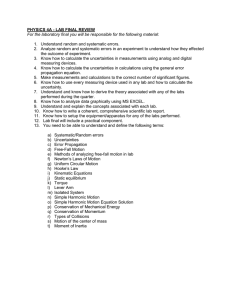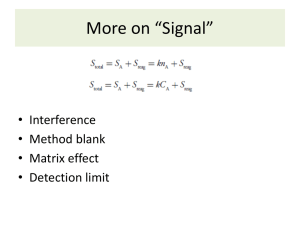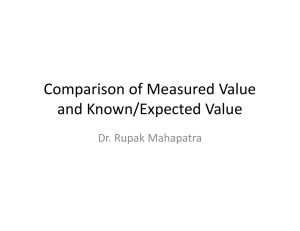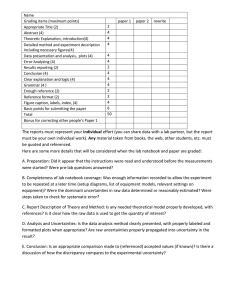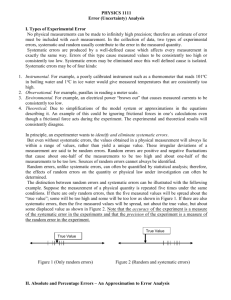Error Analysis in Analytical Chemistry: Systematic & Random Errors
advertisement
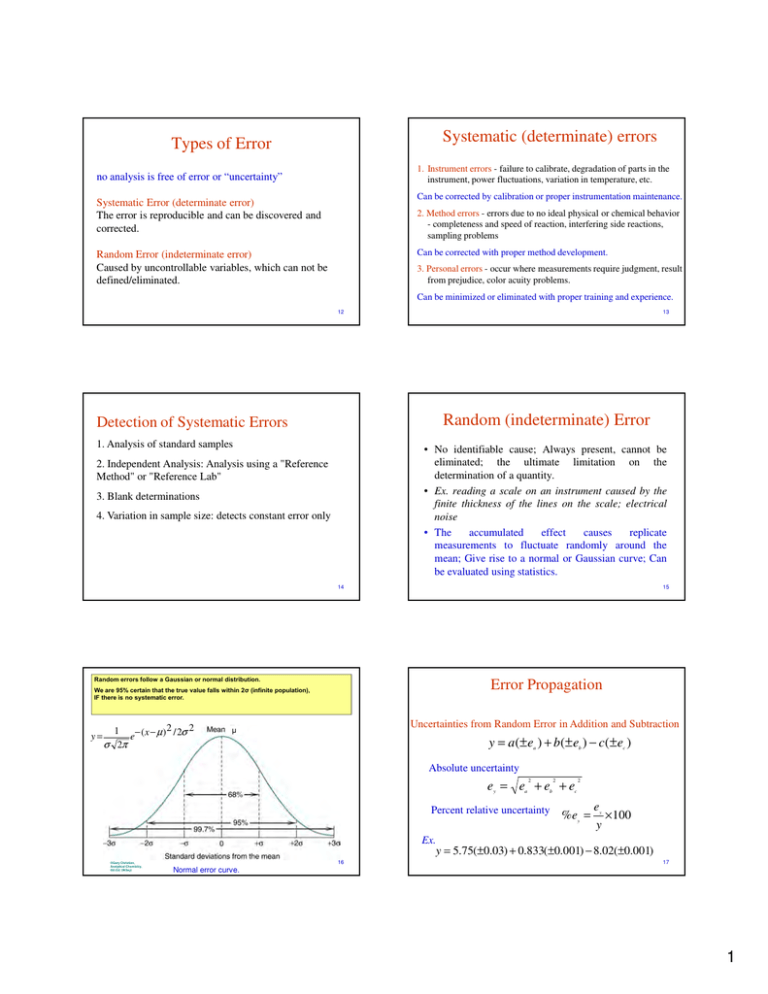
Systematic (determinate) errors Types of Error 1. Instrument errors - failure to calibrate, degradation of parts in the instrument, power fluctuations, variation in temperature, etc. no analysis is free of error or “uncertainty” Can be corrected by calibration or proper instrumentation maintenance. Systematic Error (determinate error) The error is reproducible and can be discovered and corrected. 2. Method errors - errors due to no ideal physical or chemical behavior - completeness and speed of reaction, interfering side reactions, sampling problems Can be corrected with proper method development. Random Error (indeterminate error) Caused by uncontrollable variables, which can not be defined/eliminated. 3. Personal errors - occur where measurements require judgment, result from prejudice, color acuity problems. Can be minimized or eliminated with proper training and experience. 12 13 Random (indeterminate) Error Detection of Systematic Errors 1. Analysis of standard samples • No identifiable cause; Always present, cannot be eliminated; the ultimate limitation on the determination of a quantity. • Ex. reading a scale on an instrument caused by the finite thickness of the lines on the scale; electrical noise • The accumulated effect causes replicate measurements to fluctuate randomly around the mean; Give rise to a normal or Gaussian curve; Can be evaluated using statistics. 2. Independent Analysis: Analysis using a "Reference Method" or "Reference Lab" 3. Blank determinations 4. Variation in sample size: detects constant error only 14 15 Error Propagation Random errors follow a Gaussian or normal distribution. We are 95% certain that the true value falls within 2 (infinite population), IF there is no systematic error. y= Uncertainties from Random Error in Addition and Subtraction 2 2 1 e− ( x − µ ) / 2σ σ 2π y = a (± e ) + b(± e ) − c( ±e ) a b c Absolute uncertainty e = e +e +e 2 y a 2 b Percent relative uncertainty 2 c %e = y e × 100 y y Ex. y = 5.75(±0.03) + 0.833(±0.001) − 8.02(±0.001) ©Gary Christian, Analytical Chemistry, 6th Ed. (Wiley) Normal error curve. 16 17 1 Error Propagation Error Propagation Uncertainties from Random Error in multiplication and a×b Division y= When performing calculation involving mixed operations (addition/subtraction and multiplication/division) 1. Perform addition/subtraction, determine absolute error of result, and then relative error of result 2. Perform multiplication/division operation using relative errors c Percent relative uncertainty %e = (%e ) + (%e ) + (%e ) 2 y Relative uncertainty 2 a b e e e e = ( ) +( ) +( ) y a b c y Ex. 2 a y = 251( ±1) × 2 b 2 c c 2 860( ±2) 1.673(±0.006) 18 Error Propagation Uncertainties from Random Error in Exponent: Error Propagation Uncertainties from Random Error for logarithms: For y = log(x) x ex y = log x For y = xa = x y = x3 %ex x = 5.981 ey = 2.13% e e 1 × x ≈ 0.434 x ln 10 x x y = log(x) x = 3.17 0.28 %ey = 3(2.13%) = 6.39% ey = (.43429)·(0.28)/(3.17) = 0.0384 y = 214.0 y = 0.501 6.39% Error Propagation Uncertainties from Random Error for natural logarithm: 0.038 Error Propagation Uncertainties in logarithms and antilogarithms, etc. y = log x ey = For y = ln(x) x ex y = 10 x = y = ln(x) 1 e e × x ≈ 0.434 x ln 10 x x x = 7.432 x 10-5 0.917 x 10-5 ey y = (ln 10)ex ≈ 2.303e x ey = (0.917x10-5)/(7.432x10-5) = 0.1233 y = -9.507 0.123 23 2 Error Propagation Random uncertainty Systematic uncertainty 24 Add the uncertainties of each term in a sum or difference 25 How do we determine error? Accuracy – closeness of measurement to its true or accepted value Systematic or determinate errors affect accuracy! Mean: Average or arithmetic mean Precision – agreement between 2 or more measurements of the sample made in exactly the same way Random or indeterminate errors affect precision! Precision: S, RSD, Cv Median: arrange results in increasing or decreasing order Accuracy: Error, Relative Error 26 Analytical Procedure Accuracy Absolute error (E) – diff. between true and measured value E = xi – xt where xi = experimental value, xt = true value Ex. xi = 19.78 ppm Fe & xt = 20.00 ppm Fe E = 19.78 – 20.00 ppm = -0.22 ppm Fe (-) value too low, (+) value too high Relative error (Er) – expressed as % or in ppt Er = x − xt i (as %); xt ×100 Er = 27 x − xt i xt ×1000 (as ppt) 28 2-3 replicates are performed and carried out through the entire experiment -results vary, must calculate “central” or best value for data set. Mean – “arithmetic mean”, average Median – arrange results in increasing or decreasing order, the middle value of replicate data Rules: For odd # values, median is middle value For even # values, median is the average of the two middle values N x i Mean = x = i = 1 N 29 3 Precision Precision Standard Deviation (S) for small data set Variance (S2) = square of the standard deviation n (x − x) 2 n-1 = degrees of freedom i = 1 i = S Another name for precision….. n ( x − x) 2 i = 1 i S= n −1 n −1 Relative Standard Deviation (RSD) RSD (ppt) = ( S ) x 1000 X Standard deviation ( ) of population: for infinite/large set of data n commonly expressed as parts per thousand (ppt) (x − µ)2 When express as a percent, RSD termed the coefficient of variation (Cv). i σ = i =1 Cv (%) = ( S ) x 100 n Where is mean or average of the population (most popular value) X 30 31 The exact value of for a population of data can never be determined (it requires an infinite # of measurements to be made). Confidence Limits: interval around the mean that probably contains µ. Confidence Interval: the magnitude of the confidence limits Confidence Level: fixes the level of probability that the mean is within the confidence limits 32 33 Are the two standard deviations sig. different? Fcalculated = 0.001382/0.0001432 = 93.1 Significant? Yes according to Table 4-4 # of degrees of freedom? n-1 34 35 4 Basics of Quality Assurance 36 37 5
